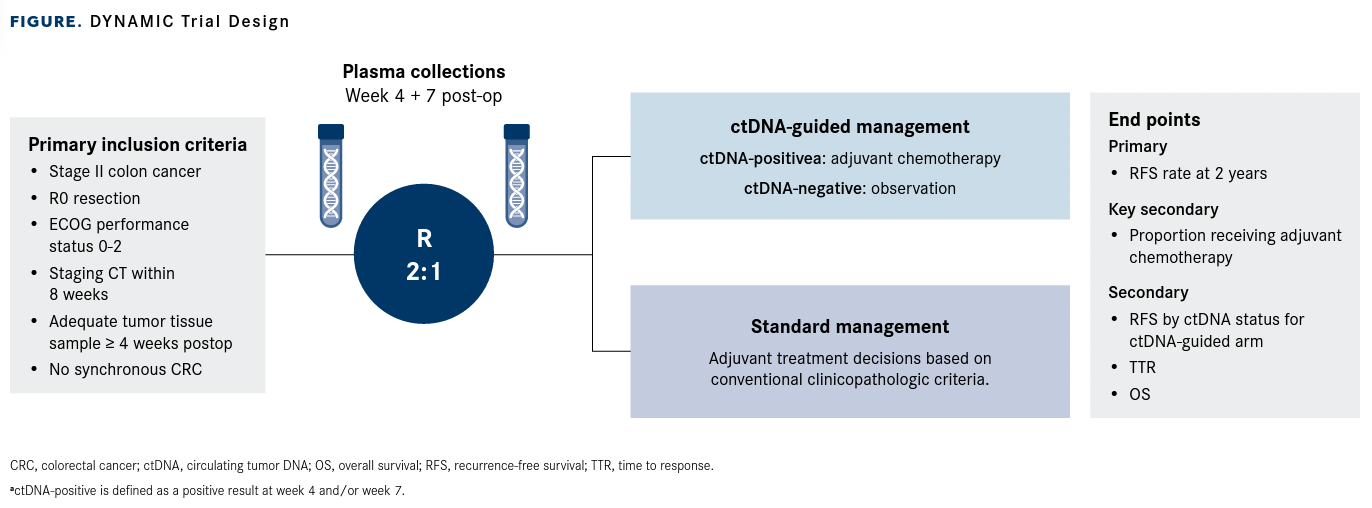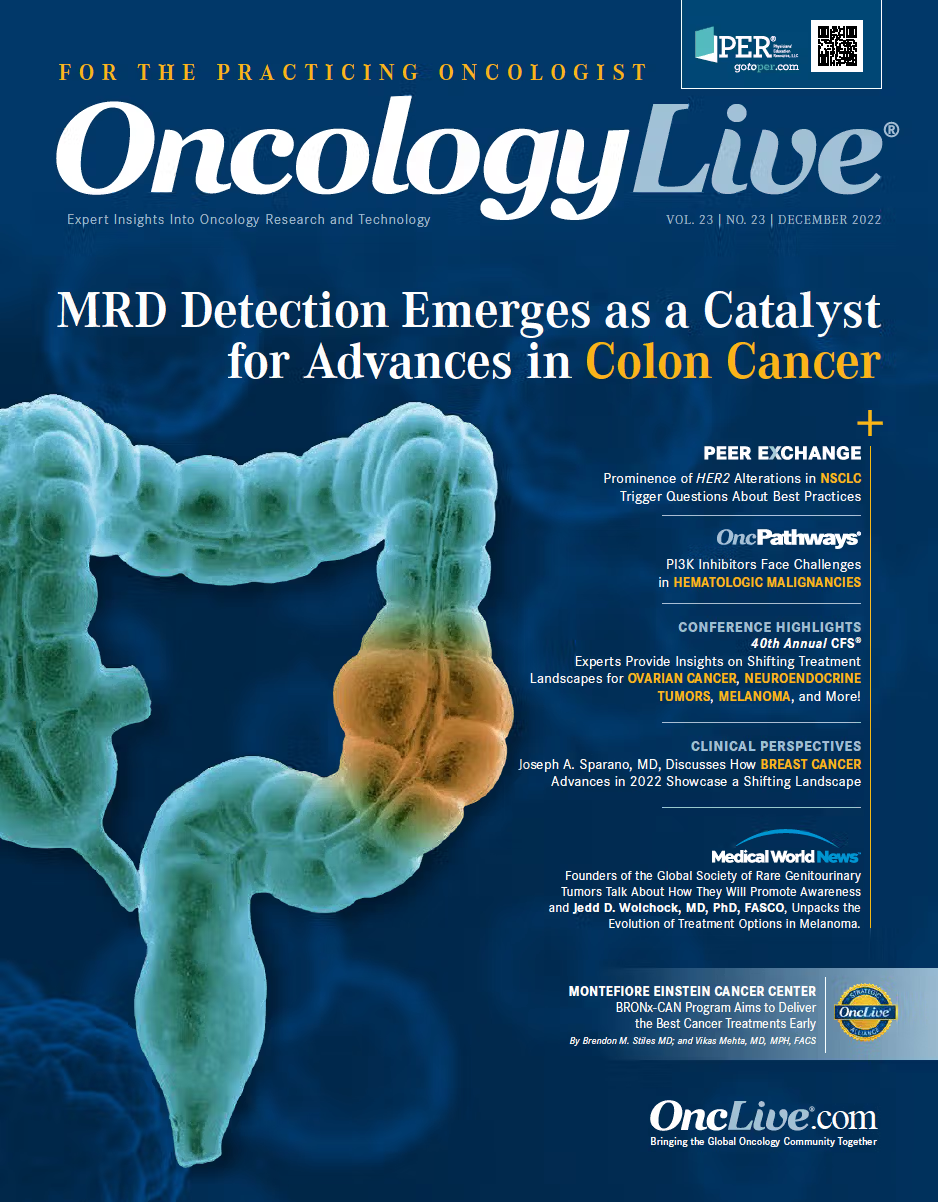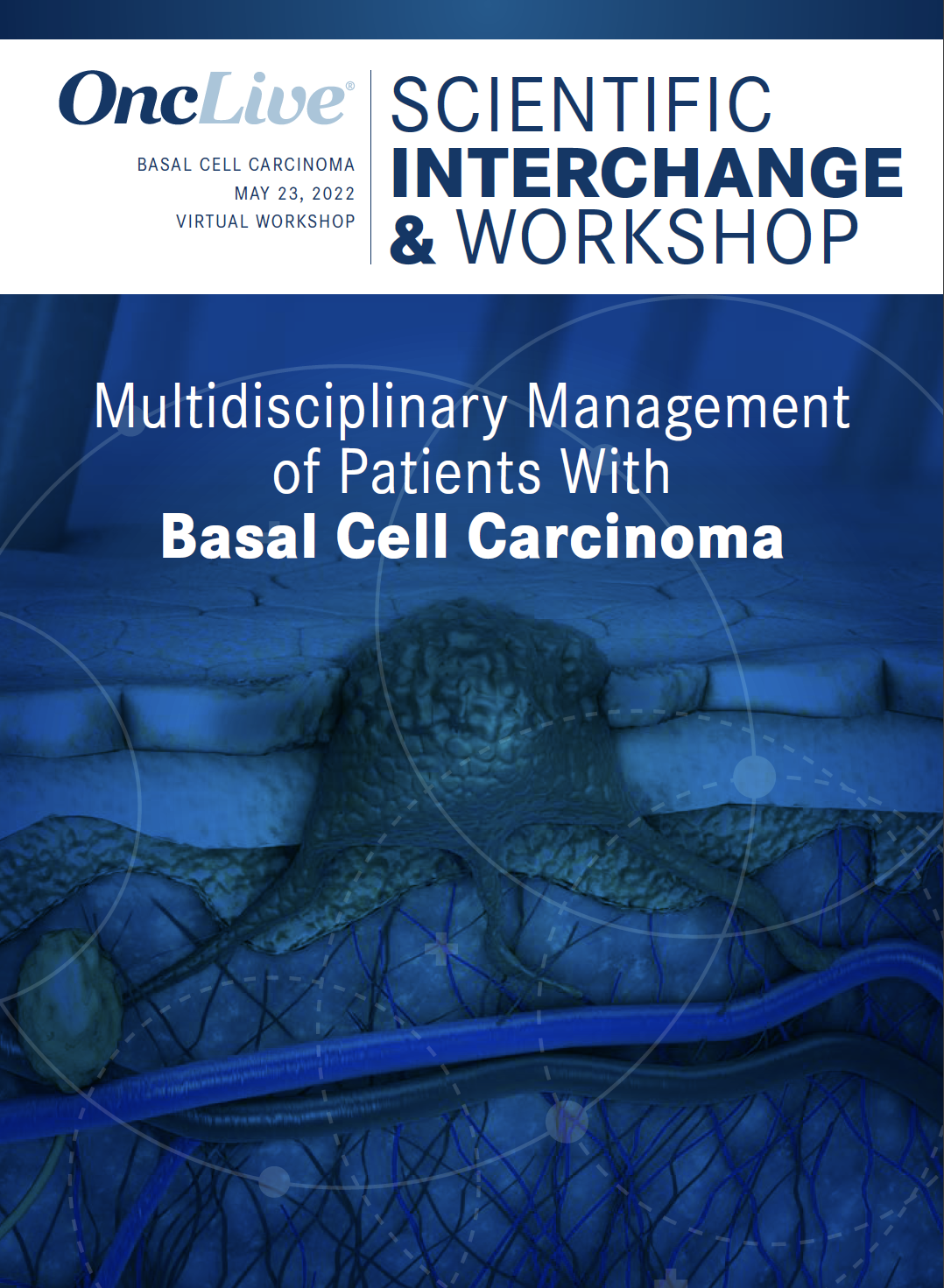Publication
Article
MRD Detection Emerges as a Catalyst for Advances in Colon Cancer
Author(s):
For patients with colon cancer, traditional clinical and pathologic risk factors may soon take a backseat as stratification tactics for determining optimal candidates for adjuvant chemotherapy.
Peter Gibbs, MBBS, MD, FRACP

For patients with colon cancer, traditional clinical and pathologic risk factors may soon take a backseat as stratification tactics for determining optimal candidates for adjuvant chemotherapy. Detection of minimal residual disease (MRD) has been evaluated more acutely in the past decade, with prognostic signals demonstrating that overtreatment may be avoided for patients who have no circulating tumor DNA (ctDNA) present following resection.1-3
“Multiple studies have documented a role for MRD in colorectal cancer, rectal cancer, colon cancer, including stage II and III disease,” Peter Gibbs, MBBS, MD, FRACP, a medical oncologist at St Vincent’s Private Hospitals and a professor at the University of Melbourne in Australia, said in an interview with OncologyLive®. “Key data support [the hypothesis] that the detection of ctDNA after surgery is associated with a very high risk of recurrence and the absence of ctDNA is associated with a low risk of recurrence. The question is: How do we use that information to best treat our patients?”
Jeanne Tie, MD

Circulating cell-free DNA (cfDNA) refers to small DNA fragments found in a cellfree component of the whole blood.4 “In terms of biologic characteristics, the length of cell-free DNA strands suggest that DNA is released in the bloodstream through cell death,” Jeanne Tie, MD, said in a presentation during the 2022 American Society of Clinical Oncology (ASCO) Annual Meeting.4 The exact mechanism of ctDNA remains to be clarified, noted Tie, the lower gastrointestinal medical oncology and trials lead at the Peter MacCallum Cancer Center and senior research fellow in the Personalized Oncology Division at the Walter and Eliza Hall Institute of Medical Research, in Melbourne, Australia.
“In healthy individuals, cfDNA is mainly derived from hematopoietic cells and is usually found at quite a low level,” Tie said. “In patients with cancer, a proportional fragment of DNA is derived from the tumor [referred to as] ctDNA. Intriguingly, tumor-derived DNA fragments appear to be smaller than normal cell-free or wild-type DNA fragment size. Therefore, apart from genomic and epigenetic changes that can be detected in ctDNA and that’s used to inform clinical practice, there’s now increasing interest in using fragment size to differentiate between ctDNA and cfDNA or to aid the accuracy of ctDNA testing in addition to genomic sequencing.”
High-risk of recurrence is determined by factors including staging (ie, T4 disease), lymph node involvement, presence of tumor deposits, all of which have been determined using retrospective analyses.1,3 Patients with stage III colon cancer have historically derived a greater benefit from adjuvant chemotherapy than those with stage II disease. With no definitive documentation of an overall survival (OS) benefit, predictive measures for mitigating postsurgical recurrence.
Olatunji B. Alese, MD, FWACS

“There is a relatively low absolute survival benefit from adjuvant chemotherapy, despite the substantial adverse effects associated with this modality, which makes it imperative for us to identify which patients require adjuvant chemotherapy compared to the patients that can be monitored on surveillance,” Olatunji B. Alese, MD, FWACS, said in a presentation at the 2022 ASCO Annual Meeting on the future of ctDNA.5 Alese is an associate professor in the Department of Hematology and Medical Oncology at Emory University School of Medicine, director of gastrointestinal oncology, and associate medical director of the Ambulatory Infusion Center at Winship Cancer Institute of Emory University in Atlanta, Georgia.
Pooled findings from 3 cohort studies showed that patients who had ctDNA detected in plasma samples collected 4 to 10 weeks postsurgery had worse 5-year recurrence-free survival (RFS) rates than those who did not (38.6% vs 85.5%; P < .001). Additionally, 5-year OS outcomes were poorer among those with MRD (64.6% vs 89.4%; P < .001). The studies enrolled a total of 485 patients with stage II or III colon cancer and ctDNA was detected in 12% of samples collected.6
Among the 230 patients with stage II disease, 20 patients (8.7%) had detectable ctDNA after surgery. Nearly all (99%) of patients with stage III disease proceeded to adjuvant chemotherapy compared with 22.6% of patients with stage II disease. Investigators highlighted “that detectable ctDNA in patients with a low-risk pathology, such as low-risk stage II colon cancer or a rectal patient with a ypN0 disease, is associated with a far greater recurrence risk (57%) than the highest risk pathology with no detectable ctDNA.”
Findings from a study of patients with stage II colon cancer underscore the use of ctDNA as a marker for identifying patients with a very high risk of recurrence. Among 178 patients who were not treated with adjuvant chemotherapy, 7.9% (n = 14) had ctDNA detected after surgery. At a median follow-up of 27 months, 11 patients (79%) had disease recurrence. 164 patients with negative ctDNA (n = 164), 9.8 % had disease recurrence (HR, 18; 95% CI, 7.9-40; P < .001).7
ctDNA Advantage Fuel Interest
Observational data coupled with the practical advantages of liquid biopsy compared with tissue assays which are more relegated to only 1 tumor site, are more invasive, and do not afford the opportunity of serial testing, interest in the use of ctDNA has grown.4 “The beauty of ctDNA compared with tissue biopsy is we can do longitudinal multiple blood sample collections and analysis with pertinent key findings,” Alese said.5
Tie noted that the clearance of ctDNA, which occurs primarily in the liver, is rapid with a half-life of approximately 2 hours.4 “This a very attractive feature of ctDNA in terms of a dynamic tracking of tumor burden,” she said. “The half-life’s much shorter than [carcinoembryonic antigen] CEA, for example, with half-life of 7 days, and much more dynamic in terms of monitoring cancer response of resistance compared with a CT scan.”
A variety of factors influence whether ctDNA will be detected in the blood including time from surgery, disease status, tumor shedding patterns depending on tumor type, and the type of variant.3,4 In terms of detection rates, colorectal cancer has been reported as having higher frequency of detectable ctDNA per cases.8 With reported increases in ctDNA present following a traumatic event (ie, resection) the optimal testing window for ctDNA is 4 weeks postoperation.3
Studies Underway to Bring ctDNA Into Practice
“Some factors to consider when you are requesting a ctDNA test include the targeted variants or regions examined by the assay, the type of variants covered or detected by the assay, the limit of detection for the different types of variant,” Tie said adding that more data are needed to appropriately declare ctDNA-guided treatment as a viable option in the clinic.
Studies are underway to support this path forward including the DYNAMIC trial (ACTRN12615000381583).9,10 The 2 cohorts evaluated in the study were ctDNA-directed therapy (n = 294) or standard-therapy cohort (n = 147) (Figure).9,10 Treatment decisions in the standard arm were based on clinical factors and those in the ctDNA-guided arm were able to elect whether to receive therapy or not based on results.
Figure. DYNAMIC Trial Design

Overall, 15% of patients who were ctDNA negative received chemotherapy in the guided treatment arm compared with 28% in the standard-treatment group, (RR, 1.82; 95% CI, 1.252.65).10 RFS rates were similar between arms: ctDNA-guided cohort had a 2-year RFS rate of 93.5% compared with 92.4% in the standard treatment group. The 3-year RFS rates were 91.7% and 92.4%, respectively (HR, 0.96; 95% CI, 0.51-1.82).
“ctDNA is a very useful marker in guiding adjuvant therapy,” Gibbs said, noting that even for patients who have negative or false negative results “who experience recurrence, the disease tended to be locoregional recurrence. Importantly, many of those patients can receive salvage therapy.”
In the study, which was conducted in Australia and New Zealand between 2015 and 2019, ctDNA analysis was completed for 99% of those in the guided arm (291 of 294). Two patients did not receive ctDNA-guided treatment. In this group, 45 patients were ctDNA-positive, with all except 1 receiving chemotherapy. Chemotherapy was not administered to those with ctDNA-negativity following surgery (n = 249), except for 1 patient.
There was less chemotherapy used with the ctDNA-guided approach across all patient subgroups, except for those with less than 12 lymph node yield and those over the age of 70, who tended to receive less chemotherapy in the standard therapy arm. The biggest difference in chemotherapy use, favoring less in the ctDNA-guided group, was for patients with T4 tumors (RR, 2.57; 95% CI, 1.46-4.50), high-risk characteristics (RR, 2.14; 95% CI, 1.43-3.21), and poorly differentiated tumors (RR, 5.06; 95 CI, 1.02-25.10).
In the guided cohort, recurrence or death occurred in 6% of patients with ctDNA-negative status compared with 18% of the ctDNA-positive group. The estimated 3-year RFS rate was 92.5% in patients from the ctDNA-negative group who did not receive chemotherapy compared with 86.4% in patients with ctDNA positivity treated with chemotherapy (HR, 1.83; 95% CI, 0.79-4.27). Furthermore, there was a difference in RFS by type of chemotherapy used within the ctDNA-positive group, with a 3-year RFS rate of 92.6% for those receiving an oxaliplatin-based doublet compared with 76.0% for single-agent fluoropyrimidine therapy.
A post hoc analysis of the data attempted to combine clinical characteristics with ctDNA status to further refine therapy selection. In patients with ctDNA negativity who did not receive chemotherapy, those with clinically low-risk characteristics had a 3-year RFS rate of 96.7% compared with 85.1% in those with highrisk features (HR, 3.04; 95% CI, 1.26-7.34). Those with T3 tumors with ctDNA-negative status had a 3-year RFS rate of 94.2% compared with 81.3% in those with T4 tumors (HR, 2.60; 95% CI, 1.01-6.71).
In addition to avoiding chemotherapy in some patients, knowing patients were ctDNA-positive resulted in greater use of an oxaliplatin-based doublet chemotherapy. In the ctDNA-guided group, 62% of patients received an oxaliplatin-based doublet vs just 10% in the standard arm. A single-agent fluoropyrimidine therapy was used for 90% of those in the standard arm and for 38% of those in the ctDNA-guided group.
Unanswered Questions in Postoperative Setting
In an analysis of DYNAMIC presented at the European Society of Medical Oncology 2022 Annual Congress, investigators assessed postoperative dynamics of ctDNA and sites of recurrence to inform future studies.11
“An interesting aspect of the study, which I wasn’t quite expecting was that we’re able to salvage a lot of the patients with a positive DNA result than in previous observational studies,” Gibbs said. “Other studies have shown in a patient with stage II colon cancer, if you could detect ctDNA after surgery there was close to 100% risk of recurrence. In DYNAMIC patients who received chemotherapy who were ctDNA positive, and received platinum-based chemotherapy, had a high RFS rates in excess of 80%. It suggests that we can salvage these patients that the detection of ctDNA may indicate that a patient is destined to have disease recurrence and the use of adjuvant therapy can prevent relapse in those in those patients.”
ctDNA clearance was achieved with adjuvant chemotherapy for 87% of patients with ctDNA positivity after surgery. This was also associated with favorable 2-year RFS rate of 97% with ctDNA clearance vs a 1-year RFS rate of 20% for patients without ctDNA clearance.11
“In terms of future studies, what was interesting was the end-of-treatment, DNA analysis,” Gibbs said. “What we looked at was the patients that were positive after surgery, and then patients that had adjuvant chemotherapy, what happened to their circulating tumor DNA on treatment. What we could show is that if the patient’s DNA was clear, if it went from positive to negative, that was associated with a very good outcome. Whereas patients that were persistently positive with a DNA wasn’t cleared by the chemotherapy had a high risk of recurrence. It’s opening up a new frontier of research, which we’re calling second-line, adjuvant therapy, in which patients received standard adjuvant chemotherapy.”
Gibbs said that opportunities for future research include looking at ways to clear residual ctDNA and prevent the recurrence. “It’s a new frontier for adjuvant therapy research and fascinating that it has huge potential.”
Alese echoed that sentiment stating, “For those who have access to these trials, I encourage you to enroll patients. Because I’m convinced that, as we finish enrollment and redo some of these trials, it’s likely to really change our practice. Using clearance of ctDNA as an end point for escalation/de-escalation of adjuvant chemotherapy, especially for those with highrisk disease, is an important area of research. And I’m even more excited about the possibility of using ctDNA as a surrogate for treatment response, which can arguably reduce the study duration and expedite the development of new therapies.”
References
- NCCN. Clinical Practice Guidelines in Oncology. Colon cancer, version 1.2022. Accessed November 10, 2022. https://bit. ly/3q29s8r
- Aung KL, Fischer SE, Denroche RE, et al. Genomics-driven precision medicine for advanced pancreatic cancer: early results from the COMPASS trial. Clin Cancer Res. 2018;24(6):1344-1354. doi:10.1158/1078-0432.CCR-17-2994
- Shergill A, Parikh AR. Investigating the use of circulating tumor DNA in early-stage colon cancer. Oncology. 2022;36(10):620-626.
- Tie J. The ABCs of ctDNA. Presented at: 2022 American Society of Clinical Oncology Annual Meeting. June 3-7, 2022; Chicago, IL. Accessed November 10, 2022. bit.ly/3UHbpoB
- Alese OB. Role of ctDNA in adjuvant and metastatic therapy for gastrointestinal cancers. Presented at: 2022 American Society of Clinical Oncology Annual Meeting. June 3-7, 2022; Chicago, IL. Accessed November 10, 2022. bit.ly/3UHbpoB
- Tie J, Cohen J, Lo SN, et al. Prognostic significance of postsurgery circulating tumor DNA in nonmetastatic colorectal cancer: Individual patient pooled analysis of three cohort studies. Int J Cancer. 2021;148(4):1014-1026. doi:10.1002/ijc.33312
- Tie J, Wang Y, Tomasetti C, et al. Circulating tumor DNA analysis detects minimal residual dis-ease and predicts recurrence in patients with stage II colon cancer. Sci Transl Med. 2016;8(346):346ra92. doi:10.1126/scitranslmed.aaf6219
- Bettegowda C, Sausen M, Leary RJ, et al. Detection of circulating tumor DNA in early- and late-stage human malignancies. Sci Transl Med. 2014;6(224):224ra24. doi:10.1126/scitranslmed.3007094
- Tie J, Cohen JD, Lahouel K, et al. Adjuvant chemotherapy guided by circulating tumor DNA analysis in stage II colon cancer: the randomized DYNAMIC Trial. J Clin Oncol. 2022;40(suppl 17):LBA100. doi:10.1200/JCO.2022.40.17_suppl.LBA100
- Tie J, Cohen JD, Lahouel K, et al; DYNAMIC Investigators. Circulating tumor DNA analysis guiding adjuvant therapy in stage II colon cancer. N Engl J Med. 2022;386(24):2261-2272. doi: 10.1056/ NEJMoa2200075
- Tie J, Cohen JD, Lahouel K, et al. Circulating tumour DNA (ctDNA) dynamics, CEA and sites of recurrence for the randomised DYNAMIC study: adjuvant chemotherapy (ACT) guided by ctDNA analysis in stage II colon cancer (CC). Ann Oncol. 2022;33(suppl 7):683. doi:10.1016/j.annonc.2022.07.456






